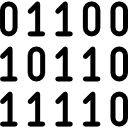Truth tables: Difference between revisions
Mr. MacKenty (talk | contribs) |
Mr. MacKenty (talk | contribs) No edit summary |
||
| Line 1: | Line 1: | ||
[[File:binary.png|frame|right|This is a basic concept in computer science]] | [[File:binary.png|frame|right|This is a basic concept in computer science]] | ||
A truth table is a mathematical table used in logic—specifically in connection with Boolean algebra, boolean functions, and propositional calculus—to compute the functional values of logical expressions on each of their functional arguments, that is, on each combination of values taken by their logical variables (Enderton, 2001). In particular, truth tables can be used to tell whether a propositional expression is true for all legitimate input values, that is, logically valid.<ref>https://en.wikipedia.org/wiki/Truth_table</ref> | A truth table is a mathematical table used in logic—specifically in connection with Boolean algebra, boolean functions, and propositional calculus—to compute the functional values of logical expressions on each of their functional arguments, that is, on each combination of values taken by their logical variables (Enderton, 2001). In particular, truth tables can be used to tell whether a propositional expression is true for all legitimate input values, that is, logically valid.<ref>https://en.wikipedia.org/wiki/Truth_table</ref> | ||
To determine the total number of possible permutations, of <syntaxhighlight lang="python" inline>n</syntaxhighlight> given inputs, You'll need 2^n input combinations to test all of the truthtable. | |||
Revision as of 12:37, 28 February 2018
A truth table is a mathematical table used in logic—specifically in connection with Boolean algebra, boolean functions, and propositional calculus—to compute the functional values of logical expressions on each of their functional arguments, that is, on each combination of values taken by their logical variables (Enderton, 2001). In particular, truth tables can be used to tell whether a propositional expression is true for all legitimate input values, that is, logically valid.[1]
To determine the total number of possible permutations, of n given inputs, You'll need 2^n input combinations to test all of the truthtable.
Truth Tables[edit]
Do you understand this topic?[edit]
- Define the Boolean operators: AND, OR, NOT, NAND, NOR and XOR.
- Construct truth tables using the above operators.
- Construct a logic diagram using AND, OR, NOT, NAND, NOR and XOR gates.
